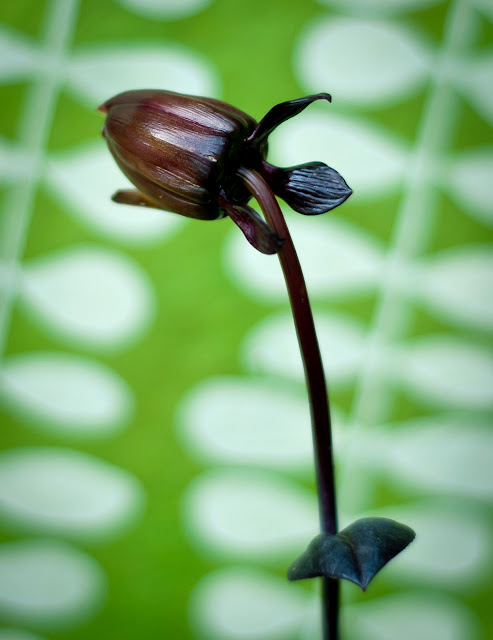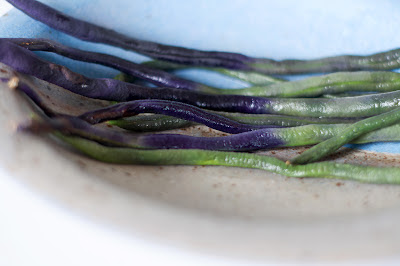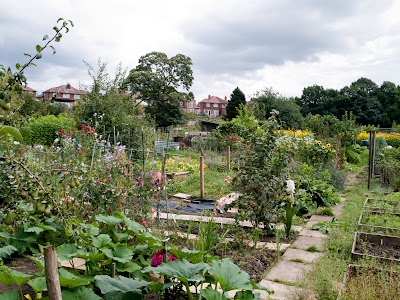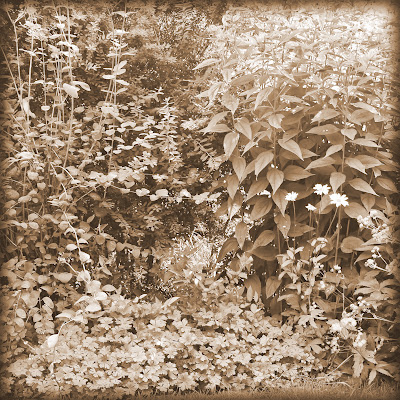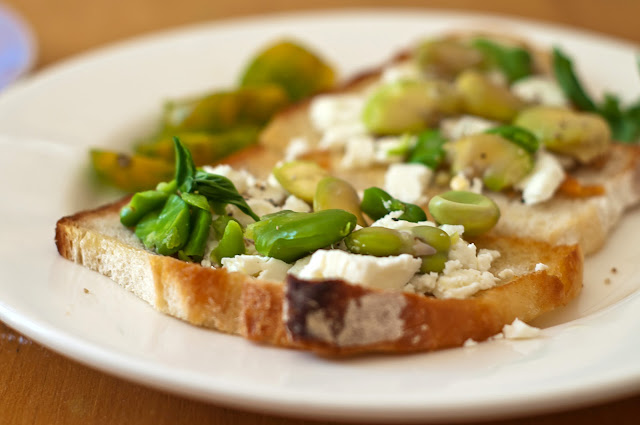30 August 2012
28 August 2012
Fun With Anthocyanins
As you will recall the original purpose of the allotment visit was to pick black beans.
When they start growing they are wonderfully curly, but eventually straighten out, and that is when you pick them.
Of course you have already noticed the papilionaceous flower shape, haven't you?
The advantage of growing these beans in your vegetable patch is not only that they look exotic thus encouraging your neighbours to think you are some kind of gourmand, but they provide the extra fun of changing colour when cooked.
Uncooked
Cooking
Half Cooked
So what is going on, where has the purpley-black colour gone? Let me explain ...
The dark colour is made of pigments called Anthocyanins (Greek: anthos = flower; kyanos = blue). These give colour to leaves, fruits, and flowers, though the final colour may be in the red spectrum not just blue. Cherries, blueberries, blackberries, wild rice, blood oranges are all examples of fruits high in anthocyanins.
Back to the beans - the dark colour disappears when cooked because the pigments break down when heated to 84C, allowing the green chlorophyll, that was always there underneath, to appear.
Another twist in the tale is that the blue colour fades in alkaline conditions. When the bean is heated some internal cells burst and release sap which is alkaline. So the anthocyanins are doomed.
This made me wonder what would happen if the beans were soaked in an acidic solution, so I dashed back into the kitchen, rescued the now limp and dully green beans, and put them in a dish of lemon juice. And, ta da, the patches that hadn't cooked and were still purple perked up into a nice inky colour. You can't really see it in these photos but trust me, there was a little bit of magic.
25 August 2012
August Rain Storm
If I were to advise anyone on starting a blog I would suggest choose your garden as a topic. It's not a sexy subject and you won't get invited to cool hipster events on the back of it. The advantage however, and it's a big advantage, is that you don't have to go hunting for something to fill your posts with - it comes to you.
An August Rainstorm - it's not sexy, and I won't be going to a cool hipster party because of it, but goodness it was mildly exciting there for a moment.
PS My son is currently at Leeds Festival. Do you think it will be worth washing the muddy clothes coming my way, or should I just throw them in the bin?
24 August 2012
It's A Gypsy Life For Me
The other morning Sally invited me back to the wonderful Bradley Fold Allotments to pick black beans from a friend's plot.
We wondered what we would do if we had a corner of the plot. Would we grow flowers or vegetables? Hollyhocks and Calendula are definitely on the list. Sally drew up plans for a pen her tortoises could use while she did some weeding - think tortoise creche.
Ideally we hoped we'd get the corner with the shed in it. Since a major part of the wish for an allotment space is the dream of just sitting outside with a book and a cup of tea (well, it is for me), this shed has the advantage of a little decking area. Can you imagine perching on there, with perhaps a glass of wine, and a woodburning stove at your feet? Sally is a vegetarian so I would probably have to bring my own sausages.
The inside of the shed would have to be cleaned up - as Sally put it 'Kath Kidsonised'. Our families would wonder why we kept taking cushions and curtains down to the allotment; surely wellies and trowels are more appropriate. Gradually the shed would turn into a place where we could escape from normal life. It occurred to us that it might get used so much a schedule would have to be drawn up, so that when we turned up in desperate need for solitude there wasn't the likelihood the other was already there, settled into her own personal refuge.
Over time we could surreptitiously bring four wheels and a couple of axles into the allotment. A wheel a fortnight wouldn’t raise any suspicions I don’t think. In the dead of night we’d do some heavy engineering. Lit by camping lamps, and with the help of a ‘Make A Wagon’ handbook, we would slide the wheels under the shed and turn it into a caravan. I haven’t worked out how we’d keep the horse a secret - though there would be plenty of food for it while we hid it - but the day would finally come when we’d hitch up the horse, sit on that decking area and go ‘giddy up’ and trot off out of the allotment, down Didsbury high street, and out into the far blue yonder.
Admittedly, being mums, we’d have to come back to make the tea and put in a new wash and find lost socks, but that moment of escape would be worth all the hassle of converting the shed to a caravan.
Or should we knock that idea on the head and grow potatoes instead?
The sound of two escaping women:
(This recording was made by Peter Wyeth who has an interesting blog)
Here are some decorative ideas:
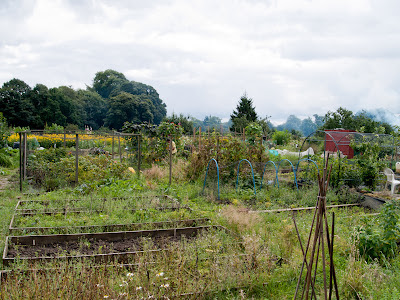 |
| Can You Spot Sally Hogging The Limelight Again? |
We wondered what we would do if we had a corner of the plot. Would we grow flowers or vegetables? Hollyhocks and Calendula are definitely on the list. Sally drew up plans for a pen her tortoises could use while she did some weeding - think tortoise creche.
Ideally we hoped we'd get the corner with the shed in it. Since a major part of the wish for an allotment space is the dream of just sitting outside with a book and a cup of tea (well, it is for me), this shed has the advantage of a little decking area. Can you imagine perching on there, with perhaps a glass of wine, and a woodburning stove at your feet? Sally is a vegetarian so I would probably have to bring my own sausages.
The inside of the shed would have to be cleaned up - as Sally put it 'Kath Kidsonised'. Our families would wonder why we kept taking cushions and curtains down to the allotment; surely wellies and trowels are more appropriate. Gradually the shed would turn into a place where we could escape from normal life. It occurred to us that it might get used so much a schedule would have to be drawn up, so that when we turned up in desperate need for solitude there wasn't the likelihood the other was already there, settled into her own personal refuge.
Over time we could surreptitiously bring four wheels and a couple of axles into the allotment. A wheel a fortnight wouldn’t raise any suspicions I don’t think. In the dead of night we’d do some heavy engineering. Lit by camping lamps, and with the help of a ‘Make A Wagon’ handbook, we would slide the wheels under the shed and turn it into a caravan. I haven’t worked out how we’d keep the horse a secret - though there would be plenty of food for it while we hid it - but the day would finally come when we’d hitch up the horse, sit on that decking area and go ‘giddy up’ and trot off out of the allotment, down Didsbury high street, and out into the far blue yonder.
Admittedly, being mums, we’d have to come back to make the tea and put in a new wash and find lost socks, but that moment of escape would be worth all the hassle of converting the shed to a caravan.
Or should we knock that idea on the head and grow potatoes instead?
The sound of two escaping women:
(This recording was made by Peter Wyeth who has an interesting blog)
Here are some decorative ideas:
20 August 2012
Garden 65 is 6 Months Old
On the 20th February earlier this year some pruning and weeding was done in the garden, then a blog was begun in the front room.
I can’t say I have hobbies. It’s a shame but commitment is just not one of my virtues. I’m a Gemini, you see: fickle, wordy, with a paranoid fear of ‘heaviness’. Beyond my life circumstances I can’t claim to be anything. I’m not a writer, painter, astrologer, cyclist, photographer, dressmaker ... all of which I’ve had an interest in. Over the years I’ve come to terms with this inability to become expert in anything. Instead of hobbies I have projects. It’ll be on my tombstone: ‘She had projects’.
Thus we can explain Garden65 as a project. And it’s a miracle it’s managed to reach 6 months old. Well done.
But, then, what of the garden, so intimately linked with the blog? I’ve been working on the garden for 12 years, and there was one before, that got played with for 10 years. In contrast to the newest interest that managed to amuse my monkey mind, the gardens have kept my attention. Neither was neglected. Weeds didn’t take over, and children were not allowed to trample them into a muddy mess. True, they were spaces that weren’t planned and controlled; they won’t be appearing in the NGS Yellow Book. But I’ve never turned my back on them. They’ve never been metaphorically put away in a cupboard.
As Garden65 attests I don’t know how to garden – composting is a new adventure, and until this year I felt affection for Lily beetles – so it’s not the hobby of gardening that sustains the engagement with my gardens. Perhaps the reason is because I have a relationship with the garden; it is an entity of itself. The garden is as complicated, frustrating, and lovely as a person. This year it shed some dark trees and become lighter and happier. But something traumatic happened to its pond, and the jury is still out on the new cat that is unusually friendly but kills frogs. Beyond the stories it can tell the garden provides emotional solace. I think everyone (every woman?) who has a garden has felt tension lift when they have walked out of the back door. Be it rainy or sunny a garden will always raise a tiny inaudible sigh.
My garden is not my project or hobby, it is my friend, and this blog is a record of that friendship.
Oh god, too heavy! Quick say something funny.
Look at the latest project – this year's embroidery interest on top of last year's natural dye fetish - what the hell am I going to do with it?
18 August 2012
The Irony of Post-modern Photography
Some thoughts on modern photography:
My daughter takes pictures on her phone then loads them up to Instagram to get that authentic “look how cool and groovy my life is” look. These aren’t a clear record of whatever friend or kitten she points the phone at, but that isn’t important. The point of the blurry orange-toned images is not to capture a moment in time, as photographs used to do. Today digital images have to have a post-modern ironic spin to them, though I don’t think the people who use Instagram realise they are doing this.
When I was studying photography academically we were told a photograph used to be about saying “I was there”. Think about your holiday snaps. However, now that photographs can be taken by your phone and instantly sent to friends or uploaded to Facebook the unspoken message of the image is “I am here”. With Instagram and other software packages that alter the look from that taken directly by the device the photographer is unwittingly saying something else. Deliberately distorting the picture might be a way of distancing yourself from the now. Is the implicit message “I am so cool I am barely here”, or “I am here but am superior to it all”?
Isn’t it interesting that as digital cameras become increasingly accurate the fashion for grainy over-exposed imagery is growing? What’s going on? I would like to think it is because people miss the magic of old style film photography.
There is that lovely feeling of nostalgia when you look at the photographs of your childhood in the 70s. These are now fading to orange or blue, and will one day, I’m afraid to say, disappear entirely, but for now you can’t help associate hazy pictures with good times.
Black and white photographs taken in earlier years are keeping their precision longer, but there is a strange distancing effect to them. Somehow people seem to be further away than if they had been taken with modern cameras. It’s like the difference between a television programme filmed with a digital camera and one made with a film camera; the actors look nearer and more present when filmed by a video camera.
This has something to do with the lenses and internal workings of the particular camera. You’ll be glad to know I won’t go into that here, but it’s worth noting imagery captured by film has a mysterious, perhaps even an ennobling quality.
Blogs about gardens are built on photographs of plants and insects (and cats). The more accurate these are the better they are at showcasing the flowers or vegetables or whatever the author wants to talk about. Some are amazing, some duff. I tell myself my own garden photos are ‘for illustrative purposes’ so I don’t have to worry about the quality too much – it’s the lazy photographer’s mantra.
Just for fun I have taken some images using an old Kodak twin reflex camera bought on eBay. Tragically they don’t make the actual film anymore that would fit in the camera, so I cheated and shot through the eye piece of the old camera with my normal digital camera. To help with light and focussing and all that a cardboard tube, about a metre long, had to be rigged up. Then some nifty Photoshopping was called for to bring out the images.
 |
| Looking down the tube to the top of the camera |
 |
| Tube made from an Amazon box, a Tesco Finest biscuit box, and the box from cereal bars. These are sellotaped and strapped to the top of the camera. |
Isn’t the final result gorgeous? These aren’t of Garden65 as it is. These are the garden as seen in a dream.
Rarely does post-modern irony produce any beauty (just ask Grayson Perry) but I think in this case it has.
16 August 2012
A Garden Design Tip For Small Gardens
There is a first time for everything. Despite my antipathy towards garden designers I’d like to pass on a garden design tip.
Yes, for the first time Garden65 strays away from the minutiae of composting and the tedium of taxonomy, and faces up to the fact that at this tail end of the summer it is looking raggy and tired.
There is need for order in the borders.
The following advice doesn’t solve the problem overnight but I thought it was an interesting approach. A contributor on an American blog 'GardenRant’ (highly recommended) sent pictures of her garden to a landscape architect called Thomas Rainer. In his opinion contrast, in terms of colour and form, is the way to create the impression of depth and space in a small garden.
“He counsels discipline: “Don’t bring a plant into that garden unless it has a striking form (spiky, billowing, vertical spire), strong foliage color (blues/golds/purples, etc), or a long season of blooms (2 month minimum). In a small space, each plant must earn its keep. Expect more, get the perfect cultivar, and continue to adjust. Imagine the plant in your garden in black and white. Does it still read? Does it still contrast from its neighbor?”
While I mull that over I did the easy bit and took black and white photos of the great walls of plants that currently loom over the lawn. Of course, I couldn’t help tweaking them into a pastiche of old Fox Talbot images, but generally I think we can safely say contrast isn’t a primary design principle of Garden65.
14 August 2012
Broad Bean Bruschetta
Today's lunch was a bruschetta made with broad beans grown in the garden.
I live the dream - I feed myself with my own organic efforts. It's one up on 'The Man'.
The excitement must be tempered however with the fact this is the sole crop of the year and it was only enough to cover a slice of bread. And - whisper it - they didn't taste as good as the ones Tescos sell. But still, they were chemical free with zero carbon foot print (well, from plant to plate, not seed to seedling seller), so the right thing has been done.
12 August 2012
Unidentified Tree That Won't Die
 |
| Can you spot That Cat? |
 |
| Mystery Tree |
Sally has suggested it may be a Sumac or Rowan tree.
 |
| Sumac |
 |
| Rowan |
I've never let it live long enough to see if the leaves turn red in the autumn or if it produces berries, so I couldn't say for certain if it is one of these.
What about an Ash?
 |
| Common Ash |
I posted it on I Spot and 'Lavateraguy' from Cheshire has identified it as an Ash (Fraxinus excelsior)
According to the Forestry Commission Ash can grow to 40m tall - hmmm. But then again in Norse myth it is associated with rebirth and healing and all sorts of good things.
Googling, I found this description which seems to solve the riddle:
"There can be anything from four to eleven pairs of leaflets with a single leaf at the end (odd pinnate). These leaves are very like those of the rowan at first glance (rowan is sometimes known as ‘mountain ash’)"
Perhaps I should let it live.
Source of quote
10 August 2012
Micro Organisms In The Compost Bin
In the last post micro organisms took centre stage. These are the single-celled little guys who are going to eat up all those banana skins and pizza boxes to make nutritious humus for my roses. What heroes. But how are they going to do that and how long will it take, and who are they?
The vast majority are bacteria. Most are the kind you wouldn’t want to meet on a dark night, but some are responsible for the antibiotics we use to fight illnesses like TB. Bacteria will eat anything, living or dead. The general idea is that they will break down matter to use the carbon and nitrogen and in doing so release gases like CO2, generate heat, and finally leave organic matter that can be used by plants.
There are three types of bacteria that get to work at different times in a compost bin:
- Psychrophilic – appear when the compost is new and cold. They prefer temperatures between 10 and 21C.
- Mesophilic – are dominant when the internal temperature rises to 21 - 38C. If there is not enough nitrogen or oxygen the compost will stay at this phase and will not develop further, so the pile needs to be turned to give these bacteria plenty of food.
- Thermophilic – appear when the compost gets hot. It’s only after the temperature reaches about 70C or they run out of carbon that the population declines.
It is surprising how quickly the temperature inside the bin rises. The earlier cooler phases last only a few days. By breaking down the sugars and starches that are easy to get to the early bacteria populations raise the temperature enough for the thermophilic bacteria to grow. It is during this hot phase when dangerous pathogens get killed off and more difficult cellulose rich material is broken down. After this intense phase, which could last days or months, a longer more sedate period starts where the work really begins. I imagine this is when they creepy crawlies and worms do their stuff.
I’ve just stuck a cooking thermometer (normally used by my son to temper his chocolate – that’s another story) into my compost bin. It’s 26C, which means it’s still in the mesophilic stage. Super. The little guys are starting to do their thing, but the big boys haven’t arrived yet. (And yes, mum, I did clean the thermometer after)
I hope this little exposition hasn’t been too boring. Bear with me, it’s just that I’m a little in love with my compost bin at the moment and I want to know ALL about him.
8 August 2012
Why Newspaper Is Added To Compost
So why am I adding newspaper to the compost bin? Let me explain the apparent madness.
The dream behind the composting effort is that the veg. peelings and shrub prunings are going to be eaten by micro organisms who after their gluttonous orgy will leave behind a nutrient rich humus I will use to mulch my Albertine rose, that in turn will then cover the fence in a beautiful luxuriant mass of flowers.
OK, so we’d better provide the right environment and food stuffs (think oysters, champagne and mood lighting) to encourage the micro organisms to do their thing quickly and efficiently. If we leave the environmental factors (temperature, water, etc) to one side, and look at the material they will consume it becomes apparent an optimum amount of carbon and nitrogen is needed. Carbon is used for energy, and nitrogen to build cell structure. As these organisms live for only 20 minutes or so a lot of carbon and nitrogen rich vegetable matter needs to be provided to fuel the many generations it will take to turn twigs and egg shells into useable compost.
A balance of both elements within the compost bin needs to be maintained. Too much carbon slows the process down because the organisms don’t have enough nitrogen to complete the process of decomposition, and alternatively if there is a surfeit of nitrogen it will escape the bin as a gas, nitrous oxide, a foul smelling waste of the very nutrient you are trying to capture for your plants. People who study these things say a ratio of about 30 parts carbon to 1 of nitrogen is the right mix to enable efficient decomposition. This ratio is generally written as 30:1.
Having learnt that lets look at what we are putting in the compost bin to see if it fits that ratio.
Composting people divide the waste put in compost bins into ‘green’ and ‘brown’ material. Green has more nitrogen in it than brown material. For example, kitchen waste with a ratio of 25:1 has more nitrogen in it than shredded newspaper at 175:1. As it’s usually the green kind of waste that gets added to compost bins some brown stuff needs to be included to up the carbon content. Adding newspaper or cardboard has an added benefit in that green material tends to be fine-textured and moist. If that is all there is in the bin you will end up with a bad smelling sludge, so layering it with dry cardboard opens up the texture (so those micro organisms can breathe) and dries the mixture a little.
The advice scientists and Mr McGregors the world over give is each time you put something in the bin use 50% green and 50% brown material, eg, a bucket of weeds and a bucket of dry leaves.
So this is what I am trying to do with my brand new compost.
However, I’ve no idea if I’m doing it right. I’m throwing in pizza boxes and shredded Guardians, but goodness knows if that is the same volume of green stuff. It’s really a matter of ‘does it look like the pictures in the composting books borrowed from the library?’. No actual measuring is involved.
Apparently you can roughly calculate your C:N ratio by adding up the various ratios of the waste you’ve chucked in then dividing by the number of units. For instance if you added equal parts of kitchen waste, grass clippings and leaves you get this neat formula which ends in a good enough ratio of 34:1:
Now let’s look at an estimation of my mix. ‘Some weeds and a couple of boxes’ give a ratio of 102:1.
Hmm.
The dream behind the composting effort is that the veg. peelings and shrub prunings are going to be eaten by micro organisms who after their gluttonous orgy will leave behind a nutrient rich humus I will use to mulch my Albertine rose, that in turn will then cover the fence in a beautiful luxuriant mass of flowers.
OK, so we’d better provide the right environment and food stuffs (think oysters, champagne and mood lighting) to encourage the micro organisms to do their thing quickly and efficiently. If we leave the environmental factors (temperature, water, etc) to one side, and look at the material they will consume it becomes apparent an optimum amount of carbon and nitrogen is needed. Carbon is used for energy, and nitrogen to build cell structure. As these organisms live for only 20 minutes or so a lot of carbon and nitrogen rich vegetable matter needs to be provided to fuel the many generations it will take to turn twigs and egg shells into useable compost.
A balance of both elements within the compost bin needs to be maintained. Too much carbon slows the process down because the organisms don’t have enough nitrogen to complete the process of decomposition, and alternatively if there is a surfeit of nitrogen it will escape the bin as a gas, nitrous oxide, a foul smelling waste of the very nutrient you are trying to capture for your plants. People who study these things say a ratio of about 30 parts carbon to 1 of nitrogen is the right mix to enable efficient decomposition. This ratio is generally written as 30:1.
Having learnt that lets look at what we are putting in the compost bin to see if it fits that ratio.
Composting people divide the waste put in compost bins into ‘green’ and ‘brown’ material. Green has more nitrogen in it than brown material. For example, kitchen waste with a ratio of 25:1 has more nitrogen in it than shredded newspaper at 175:1. As it’s usually the green kind of waste that gets added to compost bins some brown stuff needs to be included to up the carbon content. Adding newspaper or cardboard has an added benefit in that green material tends to be fine-textured and moist. If that is all there is in the bin you will end up with a bad smelling sludge, so layering it with dry cardboard opens up the texture (so those micro organisms can breathe) and dries the mixture a little.
The advice scientists and Mr McGregors the world over give is each time you put something in the bin use 50% green and 50% brown material, eg, a bucket of weeds and a bucket of dry leaves.
So this is what I am trying to do with my brand new compost.
However, I’ve no idea if I’m doing it right. I’m throwing in pizza boxes and shredded Guardians, but goodness knows if that is the same volume of green stuff. It’s really a matter of ‘does it look like the pictures in the composting books borrowed from the library?’. No actual measuring is involved.
Apparently you can roughly calculate your C:N ratio by adding up the various ratios of the waste you’ve chucked in then dividing by the number of units. For instance if you added equal parts of kitchen waste, grass clippings and leaves you get this neat formula which ends in a good enough ratio of 34:1:
25:1 + 17:1 + 60:1 = 102:3 = 34:1
Now let’s look at an estimation of my mix. ‘Some weeds and a couple of boxes’ give a ratio of 102:1.
20: 1 + 20:1 + 20:1 + 350:1 = 410:4 = 102:1
Hmm.
6 August 2012
Lots Of Compost Bins
I got a text from Sally this morning. She had been given the key to the magic kingdom and would I like to join her? Of course! So abandoning all domestic duties we snuck in - and what a wonderful place it was full of ruby red raspberries, crispy skinned onions, giant cardoons, sunny nasturtiums, and most excitingly of all: - compost bins!
In reality Sally had the key to our local allotments in Didsbury because friends of hers, who have a plot there, are away on holiday and have asked her to pick their raspberries. These allotments are behind a thick hedge and a padlocked gate, so I’ve never seen them. It’s like a whole new world in there where people committed to vegetables have created an ordered and beautiful space. The purpose of my visit was to see how proper gardeners create compost bins, but I have come away inspired to spend more time on the garden as a whole. I have to say that having been to open gardens and an RHS flower show this summer it is these allotments that have impressed me the most. Now there is a little voice in my head saying, ‘You want this too, don’t you? Admit it, go on’.
Worryingly not one of these piles has newspaper and cardboard in it.
But I'm glad to see pallets being used to construct the bins.
Some looked like World War 1 rampart walls.
Plastic darlek-like bins were also being used.
And some people had professional two bin systems.
With roofs.
Nearly all were covered. I'll have to find a bit of old carpet.
In reality Sally had the key to our local allotments in Didsbury because friends of hers, who have a plot there, are away on holiday and have asked her to pick their raspberries. These allotments are behind a thick hedge and a padlocked gate, so I’ve never seen them. It’s like a whole new world in there where people committed to vegetables have created an ordered and beautiful space. The purpose of my visit was to see how proper gardeners create compost bins, but I have come away inspired to spend more time on the garden as a whole. I have to say that having been to open gardens and an RHS flower show this summer it is these allotments that have impressed me the most. Now there is a little voice in my head saying, ‘You want this too, don’t you? Admit it, go on’.
Worryingly not one of these piles has newspaper and cardboard in it.
But I'm glad to see pallets being used to construct the bins.
Some looked like World War 1 rampart walls.
Plastic darlek-like bins were also being used.
And some people had professional two bin systems.
With roofs.
Nearly all were covered. I'll have to find a bit of old carpet.
4 August 2012
Composting Begins
Let the show commence.
As Anna imaginatively observed the new and empty compost bin
looked like a stage set ready for a magic show to start.
With some first night nerves the players have now begun to
assemble. The boards they are treading on are made of black bamboo sticks. This
foundation layer is there to allow air to circulate and be open enough to let
earthworms come up from the stalls and participate in the whole composting
event.
I think we can visualise this first act of the show as of
similar epic scope as the beginning of the Olympic opening ceremony. So here we
have a general accumulation of earthy peasants pleasantly going about their bucolic
lives. First a layer of old weeds appears accompanied by a sobering mix of torn
newspaper. Then the excitement increases when the first mound of kitchen waste enters
stage right. This adds a colourful, fruity tone to the show that the fruit
flies (who have been queuing round the corner all night to be sure of the cheap
seats) particularly appreciate. Lastly a generous mound of jasmine clippings swarms
onto the set. Although their sweet nitrogenous nature is tempered with cardboard
from pizza boxes the stage manager worries the jasmine will start saying their
lines too quickly and will end up in a mushy mess of incoherence.
So we haven’t yet got to the part of the show where Kenneth
Branagh turns up in a top hat - the assembling of green peasants will run for a
few more weeks - but all in all it looks a good beginning.
And the critics seem to be favourable
2 August 2012
I Make A Compost Bin
Here is my lovely new compost bin.
No longer will there be awkward silences when someone asks 'do you compost?' Not only can I reply 'absolutely!', but I can proudly add 'and I made it myself'.
The back is a pallet robbed from a neighbour's skip (shh), and the sides are old fence panels. A trench was dug to sit them in, and the panels are packed with bricks to keep them steady. A trick remembered from my previous life as an archaeologist: the central poles of Iron Age roundhouses were packed with stones. Don't know if it will work but if it's good enough for the ancients...
The bin is bigger than planned. To be honest I'm not sure it will ever get filled. In one way it will be a shame if it did. The space inside it, in it's clean unused state, is lovely and cosy like a den. The turned earth smells lovely and if you crouch inside no one can see you. It's a secret place that makes me want to raid the kitchen for a pork pie and bottle of ginger beer, and spend the afternoon reading a book about horsey girls going to gymkhanas.
Subscribe to:
Posts (Atom)
